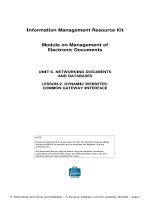Assigment 2 1619 Networking
Bạn đang xem bản rút gọn của tài liệu. Xem và tải ngay bản đầy đủ của tài liệu tại đây (1.45 MB, 47 trang )
ASSIGNMENT 2 FRONT SHEET
Qualification
BTEC Level 5 HND Diploma in Computing
Unit number and title
Unit 2: Networking Infrastructure
Submission date
16/12/2022
Date Received 1st submission
Re-submission Date
16/12/2022
Date Received 2nd submission
Student Name
Tran Duc Long
Student ID
Class
GCH1106
Assessor name
GCH210562
Michael Omar
Student declaration
I certify that the assignment submission is entirely my own work and I fully understand the consequences of plagiarism. I understand that
making a false declaration is a form of malpractice.
Student’s signature
Grading grid
P5
P6
P7
P8
M3
M4
D2
D3
2.1
Summative Feedback:
Resubmission Feedback:
3.1
Grade:
Assessor Signature:
Date:
Table of Contents
A.Introduction ............................................................................................................................................................... 4
B. Task 1 - Provide a logical/physical design of the networked system with clear explanation and addressing table
(P5): ............................................................................................................................................................................... 4
1. Explain the difference between logical and physical design. ................................................................................ 4
2. Discuss and explain the user requirements for general network design. ............................................................. 6
3. Provide a logical design of the network based on the specific requirements of the user. ................................... 7
4. Provide a physical design of this network based on the specific requirements of the user. ................................ 7
5. The address table of the network devices used in the design above. .................................................................. 8
C. Task 2 - Evaluate the design to meet the requirements (P6) .................................................................................... 8
1. Test plan: ............................................................................................................................................................... 8
2. Evaluate network design ....................................................................................................................................... 9
-Benefits: ............................................................................................................................................................... 9
- Drawback:............................................................................................................................................................ 9
- Conclusion: ........................................................................................................................................................ 10
D. Task 2.1 - Install and configure network services and applications on your choice (M3) ...................................... 10
Configure DHCP services ......................................................................................................................................... 10
E. Task 3 - Implement a networked system based on a prepared design (P7) ........................................................... 14
1. Network Implementation .................................................................................................................................... 14
2. Diagrams: ............................................................................................................................................................. 32
F. Task 4 - Document and analyse test results against expected results (P8) ............................................................. 35
1. Implementation process...................................................................................................................................... 35
2. Document ............................................................................................................................................................ 36
3. Test result ............................................................................................................................................................ 37
G. Task 4 .1- Recommend potential enhancements for the networked systems ....................................................... 40
H. Task 4 .1.1 Use critical reflection to evaluate own work and justify valid conclusions .......................................... 41
I. Conclusion ................................................................................................................................................................ 42
K. Reference ................................................................................................................................................................ 42
5.1
Table of Figure
Figure 1: Physical Topology ........................................................................................................................................... 5
Figure 2:Logical Topology .............................................................................................................................................. 5
Figure 3: Logical design ................................................................................................................................................. 7
Figure 4:Physical design ................................................................................................................................................ 7
Figure 5: Router 1 Fa0/0 .............................................................................................................................................. 15
Figure 6: Router 1 S2/0 ................................................................................................................................................ 16
Figure 7: Router 2 Fa0/0 .............................................................................................................................................. 17
Figure 8: Router 2 fa1/0 .............................................................................................................................................. 18
Figure 9:Router 2 S2/0................................................................................................................................................. 19
Figure 10: Router 2 Fa6/0 ............................................................................................................................................ 20
Figure 11:DHCP1 IP address ........................................................................................................................................ 21
Figure 12: HTTP IP address .......................................................................................................................................... 22
Figure 13:DNS IP address............................................................................................................................................. 23
Figure 14: DHCP2 IP address ....................................................................................................................................... 24
Figure 15: Salemans IP address ................................................................................................................................... 25
Figure 16: Manager IP address .................................................................................................................................... 26
Figure 17:IT2 IP address .............................................................................................................................................. 27
Figure 18: Customers IP address ................................................................................................................................. 28
Figure 19:IT1 IP address .............................................................................................................................................. 29
Figure 20: IT IP address................................................................................................................................................ 30
Figure 21: Customer1 IP address ................................................................................................................................. 31
Figure 22:Customer2 IP address.................................................................................................................................. 32
Figure 23: Ground floor ............................................................................................................................................... 33
Figure 24: First Floor.................................................................................................................................................... 34
Figure 25: Second Floor ............................................................................................................................................... 34
Figure 26: Overview..................................................................................................................................................... 35
A.Introduction
The logical and physical designs will be introduced and compared in this project. The major topic
presented and described is the customer's network design needs. It's a system for a local
educational institution that includes 50 lab computers, 35 staff PCs, and three printers, all of
which have dynamic IP addresses. A logical design, as well as a physical design and an IP address
table, will be delivered in response to that request. Following the creation of a test plan and the
evaluation of this network system, a solution to solve the limitations will be provided. The
network design process, as well as the overall device results table, will be shown. Finally, provide
the testing findings and compare them to the customer's initial request.
B. Task 1 - Provide a logical/physical design of the
networked system with clear explanation and
addressing table (P5):
6.1
1. Explain the difference between logical and physical design.
- What is the difference between logical and physical network diagrams?
Logical network diagrams are concerned with how traffic moves throughout the network, IP addresses,
admin domains, domain routing, control points, and so on. A physical network diagram should depict the
network architecture precisely as it is: with all of the devices and their connections. The physical signaling
medium of a network (often a LAN) consists of devices, locations, and cables.
Figure 1: Physical Topology
Logical network topology: refers to the manner in which data moves via a network between devices
(computers, phones, etc.); it is independent of the physical connection. The data channel in the circuit
travels logistically.
Figure 2:Logical Topology
- What is the difference between a logical connection and a physical connection?
A logical network arrangement is the communication strategy that connects two networked
computers. A logical arrangement is the flow of data between two systems. In reality, the
network connection is defined by the network's logical design. The physical arrangement is
configured using logical scheduling. Logical networking may be improved and utilized to link two
or more machines. The virtual network design is logical, while the physical network design
specifies the operation of the network hardware. Physical designs govern the flow of data or
communication between two networks, whereas logical designs control the flow of data or
communication between two computers connected by a cable.
2. Discuss and explain the user requirements for general network design.
User needs (as stated in the report):
As we can see, I have designed the requirements with three floors: the ground floor, first floor,
and second floor.
For specifically, I will introduce each floor below:
Ground Floor: There will be 33 people on the first floor, including 15 salesmans, 12 employees, 5
managers and IT, so I decided to use 2 switches with 24 ports, 1 room for salesmans and
managers, and 1 room for it and the employees. I installed a router in case some guests come
over and use their equipment. Also, I set up 3 printers so that salesmans, employee and
managers can easily use them, and they are on the same VLAN as the PCs. The bottom VLAN It
can ping the It room on the first floor.
First floor: On the first floor, I designed an IT laboratory, a laboratory where customers learn
about computers, and a waiting room that already has routers for guests. I have 20 PCs set up for
customers in a customer lab. So I chose the underlying 24-port switch. From ports 2 to 22, I
created a VLAN customer to help the customer's lab ping the other labs on the second floor. The
remaining 2 ports I created VLANs for it and the router.
Second floor: Customer PC room, equipped with 31 PCs and routers, convenient for customers
and IT to study and connect easily. The customer VLAN helps the student labs and IT employees
ping each other as well as the labs on the first floor.
On the first level, I installed a router to link the network and a multiplayer switch. This switch is
more powerful and efficient than others, and it can link three LAN networks.
3. Provide a logical design of the network based on the specific requirements of the
user.
Figure 3: Logical design
4. Provide a physical design of this network based on the specific requirements of the
user.
Figure 4:Physical design
5. The address table of the network devices used in the design above.
Device
Interface
IP
R1
Fa0/0
Serial2/0
Fa0/0
Fa1/0
Fa6/0
Serial2/0
NIC
NIC
NIC
NIC
192.168.10.1
10.0.1.1
192.168.20.1
192.168.60.3
192.168.30.2
10.0.1.2
192.168.30.1
192.168.60.30
192.168.10.2
192.168.20.2
R2
DNS
HTTP
DHCP1
DHCP2
Default
Gateway
192.168.20.1
192.168.40.3
192.168.10.1
192.168.20.1
Subnet mask
DNS server
255.255.255.0
255.255.255.0
255.255.255.0
255.255.255.0
255.255.255.0
255.255.255.0
255.255.255.0
255.255.255.0
255.255.255.0
255.255.255.0
192.168.10.2
192.168.10.2
192.168.10.2
192.168.10.2
Ground Floor
PC salesmans
PC IT2
PC manager
PC employees
Printer salesmans
Printer managers
Printer employees
DHCP
DHCP
DHCP
F0
F0
F0
F0
PC customers
PC IT1
DHCP
DHCP
PC customer1
PC customer2
DHCP
DHCP
192.168.10.1
192.168.10.2
192.168.10.1
First Floor
192.168.10.2
192.168.10.2
192.168.10.2
Second Floor
C. Task 2 - Evaluate the design to meet the
requirements (P6)
1. Test plan:
Activity
1
Ping salesmans PCs to Printer salesmans
Expected
Reason
Successful
Same
2
3
4
5
6
7
8
9
10
11
12
13
14
15
16
Ping employees PC to Printer employees
Successful
Same
Ping managers PC to Printer managers
Successful
Same
Ping IT2 PC to IT1 PC
Successful
Same
Ping 15 customer1 PC and 15 customer2
PC to 20 customers PC
Ping 15 customer1 PC to 15 customer2 PC
Successful
Same
Successful
Same
Ping salesmans PC to manager PC
Successful
Different
Ping salesmans PC to all customers PC
Successful
Different
Ping salesmans PC to employees PC
Successful
Different
Ping salesmans PC to IT PC
Successful
Different
Ping employees PC to all customers PC
Successful
Different
Ping employees PC to managers PC
Successful
Different
Ping employees PC to all IT PC
Successful
Different
Ping manager PC to IT PC
Successful
Different
Ping manager PC to all Customer PC
Successful
Different
Ping all IT PC to all Customer PC
Successful
Different
Because I have a configuration sub-interface in the Router so the different VLAN in the network
still can ping each other. So the expected results are successful.
2. Evaluate network design
-Benefits:
The network speed is rapid since all devices may connect to each other as soon as possible,
ensuring that the connection is not isolated. Furthermore, the finish may now be easily applied or
deleted. It is an excellent model since it is basic and has few flaws. If one device fails, the entire
network is not affected.
- Drawback:
No firewall. Because there is no integrated wireless network, mobile phones and laptops cannot
connect. The prices of the gadgets have not been cut to the bare minimum.
- Conclusion:
Because my design is intended for 200 customers, 15 salesmans, 12 employees, 5 managers, and
3 IT administrators, it is conceivable that it will not be able to handle any extra employee or
customers in the future. To fast expand the network, I should choose a 36-port or 48-port switch.
D. Task 2.1 - Install and configure network services and
applications on your choice (M3)
Configure DHCP services
Services—> DHCP—> DHCP1 Set up the default getway, start the IP address and DNS server, and
save the settings. Also, keep in mind that the interface of the port to which DHCP connects is Fa0.
Then, by turning on DHCP in each device, the linked devices automatically configure the IP
address, default gateway, Subnet mark, and so forth.
As may be seen, go to Manager PCs --> Desktop --> IP Configuration —> Enable DHCP. The default
gateway, DNS server, and IP address all begin with 192.168.10.....
Finally, I repeated the process with the other computer devices, printers, and DHCP 2.
E. Task 3 - Implement a networked system based on a
prepared design (P7)
1. Network Implementation
Cisco Packet Tracer was used to implement the topology. Before we can finish the setup, we must
first accomplish the following:
• Fundamental router setup (hostnames, password, IPs)
• Configure DHCP
• Create a Static Route with a Next-Hop Address and an Exit Interface.
Consider the following network implementation:
Example the network implementation:
Figure 5: Router 1 Fa0/0
Figure 6: Router 1 S2/0
Figure 7: Router 2 Fa0/0
Figure 8: Router 2 fa1/0









